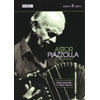Astor Piazzolla in Portrait
Remarkable films illuminating hidden facets of the Argentinian Tango King
View record and artist detailsRecord and Artist Details
Composer or Director: Astor Piazzolla
Genre:
DVD
Label: Opus Arte
Magazine Review Date: 9/2005
Media Format: Digital Versatile Disc
Media Runtime: 213
Mastering:
Stereo
Catalogue Number: OA0905D

Tracks:
| Composition | Artist Credit |
|---|---|
| Milonga del ángel |
Astor Piazzolla, Composer
Astor Piazzolla, Bandoneon Astor Piazzolla, Composer |
| Tanguedia |
Astor Piazzolla, Composer
Astor Piazzolla, Composer Astor Piazzolla, Bandoneon |
| Mumuki |
Astor Piazzolla, Composer
Astor Piazzolla, Bandoneon Astor Piazzolla, Composer |
| Adiós Nonino |
Astor Piazzolla, Composer
Astor Piazzolla, Bandoneon Astor Piazzolla, Composer |
Author: Guy Rickards
‘Piazzolla was a musical genius,’ says film director Fernando Solanas (for whom Piazzolla composed in the 1980s) in Dibb’s documentary, ‘but his social and political views were not exactly advanced. In this he was a little like Borges. But despite his questionable opinions, he succeeded in expressing the anguish, melancholy, nostalgia and depression so typical of the man from Buenos Aires.’ There was a good deal more to the man, as Dibb teases out from a host of colleagues and friends. Piazzolla was, and remains, a controversial figure in Argentina: his rejuvenation of the moribund tango genre offended a great number of his compatriots – for which he even once received a beating in the street.
There is much telling testimony from fellow musicians. Jazz percussionist Gary Burton relished the chance of working with Piazzolla to become a tango performer; Nadia Boulanger called her student an ‘idiot’ for avoiding the ‘true Piazzolla’ – the tango composer. Those who played in his bands – including his son Daniel – speak of him with a mixture of reverence and remembered terror (of the demands man and music made). Although the music is fêted worldwide, the man was flawed. Driven and passionately obsessed, his relationships with both children were difficult in later life. He was reconciled with both, Diana becoming his biographer and Daniel his nurse during his final illness.
Tanguedia – ‘a mixture of tango, tragedy and comedy’ and one of Piazzolla’s numbers for Solanas’s Tangos, el exilio de Gardel – features in his last studio recording, preserved in Tony Staveacre’s film Tango Nuevo, along with Milonga del Angel, Adios Nonino, Zero Hour and the deliberately hyphenated Sex-tet. Piazzolla’s physicality as a performer is manifest, the hub around which everything on the stage revolves. (A bonus track features a recent Milonga del Angel with Joanna MacGregor, James Crabb and members of Piazzolla’s 1980s quintet.) Ultimately, his reputation will depend on whether such music survives and if his revivification of the tango (‘vertical rape’, Borges called it) is a springboard for future composers or another dead end. Composers such as Richard Galliano keep the memory alive without advancing the medium; the Gotan 2003 Project strives to use his music to return to the clubs from which Piazzolla strove so long to remove it. This unanswerable question aside, these two well-produced films (accompanied by additional unedited interviews) flesh out the hidden depths of a very human composer, who was much more than the music he wrote but whose music came to be so much more than the man.
There is much telling testimony from fellow musicians. Jazz percussionist Gary Burton relished the chance of working with Piazzolla to become a tango performer; Nadia Boulanger called her student an ‘idiot’ for avoiding the ‘true Piazzolla’ – the tango composer. Those who played in his bands – including his son Daniel – speak of him with a mixture of reverence and remembered terror (of the demands man and music made). Although the music is fêted worldwide, the man was flawed. Driven and passionately obsessed, his relationships with both children were difficult in later life. He was reconciled with both, Diana becoming his biographer and Daniel his nurse during his final illness.
Tanguedia – ‘a mixture of tango, tragedy and comedy’ and one of Piazzolla’s numbers for Solanas’s Tangos, el exilio de Gardel – features in his last studio recording, preserved in Tony Staveacre’s film Tango Nuevo, along with Milonga del Angel, Adios Nonino, Zero Hour and the deliberately hyphenated Sex-tet. Piazzolla’s physicality as a performer is manifest, the hub around which everything on the stage revolves. (A bonus track features a recent Milonga del Angel with Joanna MacGregor, James Crabb and members of Piazzolla’s 1980s quintet.) Ultimately, his reputation will depend on whether such music survives and if his revivification of the tango (‘vertical rape’, Borges called it) is a springboard for future composers or another dead end. Composers such as Richard Galliano keep the memory alive without advancing the medium; the Gotan 2003 Project strives to use his music to return to the clubs from which Piazzolla strove so long to remove it. This unanswerable question aside, these two well-produced films (accompanied by additional unedited interviews) flesh out the hidden depths of a very human composer, who was much more than the music he wrote but whose music came to be so much more than the man.
Discover the world's largest classical music catalogue with Presto Music.

Gramophone Digital Club
- Digital Edition
- Digital Archive
- Reviews Database
- Full website access
From £8.75 / month
Subscribe
Gramophone Full Club
- Print Edition
- Digital Edition
- Digital Archive
- Reviews Database
- Full website access
From £11.00 / month
Subscribe
If you are a library, university or other organisation that would be interested in an institutional subscription to Gramophone please click here for further information.




